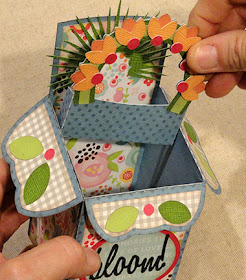Dimensional card (approx 2.75"
wide x 2.75" deep by 5.875" tall)
folds flat for sending, opens into
box tube form for display.
Two bridges cross interior box space to support design elements:
(#1) pair of layered tulips with scroll leaf stem,
and (#2) arch with 7 layered
miniature tulips.
Leaf spike arch decorates the back panel.
Layered oval card with
punch hole for mini brad
attaches to front accent panel.
"Bloom!"
word cut can express sentiment on tag.
ASSEMBLY: 1. Identify and cut the shapes:
A card base (in two halves)
B-D base outside accent panels: front and sides
E base inside back accent panel
F leaf spike arch accent
G, H & I side and front flaps with accents
J bridge #1 with flower and swirl accents
K bridge #2 with 2 arch, two-part flowers, punch dots
L front two-part tag with "bloom!" word cut
on the inside of the card base panel
in similar manner.
the top edge tab/flanges.
Center and glue in place
the flap accent shapes,
then attach punch circle into hole cutout,
leaves pair on each side.
10. Position the tab/flange of the appropriate flap unit
along the side or front edge of the box
and glue in place. Attach two side and one
front flap.
at the guide marks, and glue in place.
the outer and inner arch accent shapes.
(NOTE the final cut shape has been modified
to remove the inner 'dots' shaping.)
Build the tiny flower units by layering the petal pair
and dot shapes onto the base.
Position and attach the flower shapes over
the corresponding positions over the arch.
Bend the bridge side tabs back.
cavity until the top of the tab flange is even
with the flap fold edge.
Also take care that the bridge is perpendicular
to the box's sides.
A card base (in two halves)
B-D base outside accent panels: front and sides
E base inside back accent panel
F leaf spike arch accent
G, H & I side and front flaps with accents
J bridge #1 with flower and swirl accents
K bridge #2 with 2 arch, two-part flowers, punch dots
L front two-part tag with "bloom!" word cut
2. Prepare the card base halves by bending
back (mountain fold) at all vertical perforation lines.
3. Overlap the left edge of the half that includes
the taller back panel over the corresponding
side tab of the other half to perforation libne,
adjust so that top and bottom edges align,
and glue the side seam.
4. Prepare the tag by layering the ovals and
attaching the word cut.
5. Position the tag punch hole over the corresponding
hole on the front (center) accent panel, and attach
in place with a dab of glue and a contrast mini brad.
6. Position and attach the front side and center
accent panels over the card base corresponding
panels, with bottom edges aligned, and centered
side to side.
7. Position and attach the tall back panelon the inside of the card base panel
in similar manner.
8. Form the card into a tube to bring the side tab flange
to wrap around the corresponding side edge of
tall panel (tab will be on the outside of the card tube).
Align bottom edges, and glue in place.
9. Prepare the three flaps by bending backthe top edge tab/flanges.
Center and glue in place
the flap accent shapes,
then attach punch circle into hole cutout,
leaves pair on each side.
10. Position the tab/flange of the appropriate flap unit
along the side or front edge of the box
and glue in place. Attach two side and one
front flap.
11. Prepare to attach the spike leaf accent
by first identifying the position cut marks
on the back accent panel . . .
. . . then position the bottom inner rounded edgesat the guide marks, and glue in place.
12. Prepare the larger flower units by attaching
the front 'petal' shapes to the base shape.
13. Position and attach the left flower onto
bridge #1, then leaf swirl, then right flower.
Bend the bridge side tabs back.
14. Prepare bridge #2 by layering and attachingthe outer and inner arch accent shapes.
(NOTE the final cut shape has been modified
to remove the inner 'dots' shaping.)
Build the tiny flower units by layering the petal pair
and dot shapes onto the base.
Position and attach the flower shapes over
the corresponding positions over the arch.
Bend the bridge side tabs back.
15. Apply glue to the side tabs of bridge #2,
then insert into the interior of the box
and prepare to attach the tabs to the inside
surfaces of the side panels, at approximately
a one-third distance forward from the back.
Push the bridge downward into the boxcavity until the top of the tab flange is even
with the flap fold edge.
Also take care that the bridge is perpendicular
to the box's sides.
Before the glue sets, fold the box card into its
flattened position and apply pressure through
the layers in the areas where the tab flanges are
attaching to the box sides.
(Repeat this flattening and pressure-applying
step after bridge #1 is attached, too.)
This allows the attachment to "self adjust" slightly
if needed.
16. Insert bridge #1 in the same manner,
placing it approx. halfway between bridge #2
and box front, and attach.
Here is the flattened box prepared to
insert into an envelope for sending or giving.
Here is the completed box in its opened form.


















No comments:
Post a Comment